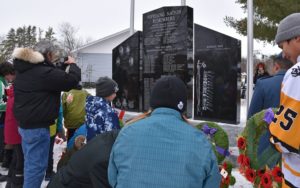Air Force Captain shown appreciation and Nipissing remembers with new cenotaph

By Kelly Anne Smith
NIPISSING FIRST NATION — Days leading up to this year’s Remembrance Day ceremony was special for Captain Kim Munro of Nipissing First Nation.
Captain Munro walked with other soldiers in the procession on Remembrance Day. Leading the way were artist Dan Commanda, Nipissing First Nation Councillor Rick Stevens, and Elder Evelyn McLeod with Anishinabek Nation Grand Council Chief Glen Hare.
Captain Munro witnessed the unveiling of the community’s new cenotaph in Garden Village along with hundreds of citizens who clapped and commented approval.
The young students of Lady of Sorrows Elementary School sang O Canada in Anishinaabemowin. A flag song was sung with the big drum close to the Sacred Fire, heard crackling during the two minutes of silence.
It had been a busy week for Captain Munro. On Nov. 9, she was singled out for attention at a Maple Leafs game in Toronto during the break between first and second periods. As part of their Canadian Forces appreciation, a photo of Captain Munro was displayed on the big screen for close to 20,000 people to see as her career was highlighted.
Captain Munro thought the night fantastic with great seats to watch her first NHL game and she got to meet NHL almunus Darryl Sittler.
“What was a bit overwhelming was that at one point of the game, they get you to stand up. They have the cameras on you and everybody in the whole arena stands up and claps and cheers for you. It was a bit humbling for me to see people appreciate what we do.”

She has gotten used to her air force blue uniform.
“I was in the army for 25 years. I was a non-commissioned member; then last May, I became an officer. I joined the Officer Corps and now I am a Captain instead of a Master Warrant Officer.”
She serves in multiple capacities including work in finance, transport and supply, among others.
“I’m a Logistics Officer at 22 Wing North Bay. There is NORAD, the bi-national collaboration between Americans and Canadians where we defend the air space in the northern part of Canada and all the coasts. My specialty is human resources.”
Captain Munro shares the meaning of Remembrance Day for her.
“I remember the many personnel I know whose families have had loved ones that passed during our Afghanistan tours. I went on Roto-Zero. It was the very first one and it was very difficult,” recalls Munro. “We had our first two killed in action there. Many of my friends and co-workers have had people in their lives that have passed as a result of this. It’s not just while on the battlefield but also as they return home and struggle with their demons, they have taken their lives. Everyone is impacted. It is very traumatic.”
Overseeing the cenotaph replacement project, Patrick Stevens says the cenotaph is dedicated to those who lost their lives, who served in any capacity, and those who continue to serve.
At the top of the monument are the words ‘Nipissing Remembers.’ Photos of four of the five soldiers killed in action from Nipissing First Nation are etched in the black marble, as are 80 names of soldiers who served in the First and Second World War and the Korean War. The crests of the Algonquin Regiment Canadian Armed Forces (CAF) badge; the Department of National Defence (DND); and the Canadian Aboriginal War Veterans and the DND/CAF Eagle Staff are featured.

The new cenotaph includes artwork by artist Dan Commanda of soaring eagles and two deer/wawashkesh and an epitaph poppy dreamcatcher.
“Deer is the emblem of our community. This morning as we started to gather, there was an eagle that flew above us as we started our procession to the cenotaph. We always honour our warriors and our people who have done outstanding work for the community with an Eagle Feather. That is what those eagles represent.”
Speaking in the language and English on the valor of the men and women who volunteer for the First and Second World Wars and the Korean War, Nipissing First Nation Deputy Chief Muriel Sawyer unveiled the cenotaph.
“The many sacrifices they made so that we may enjoy the freedom that we so often take for granted. They were not obligated to enlist in the world wars but they did so willingly, knowing the hardships they would encounter and endure. Many of our members did not return. And we owe them a debt of gratitude.”
The men from Nipissing First Nation who were killed in action during World War II are Gerald Grenville Joseph Laronde; Michael Clarence Goulais; Ambrose Stevens; James Commanda; and Lawrence K. Whiteduck.


